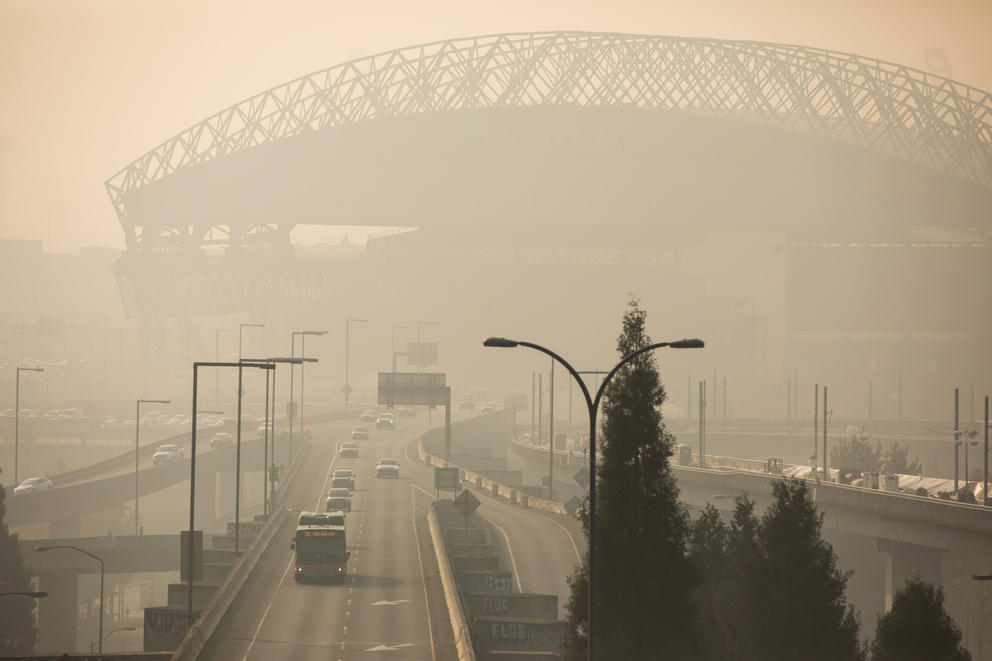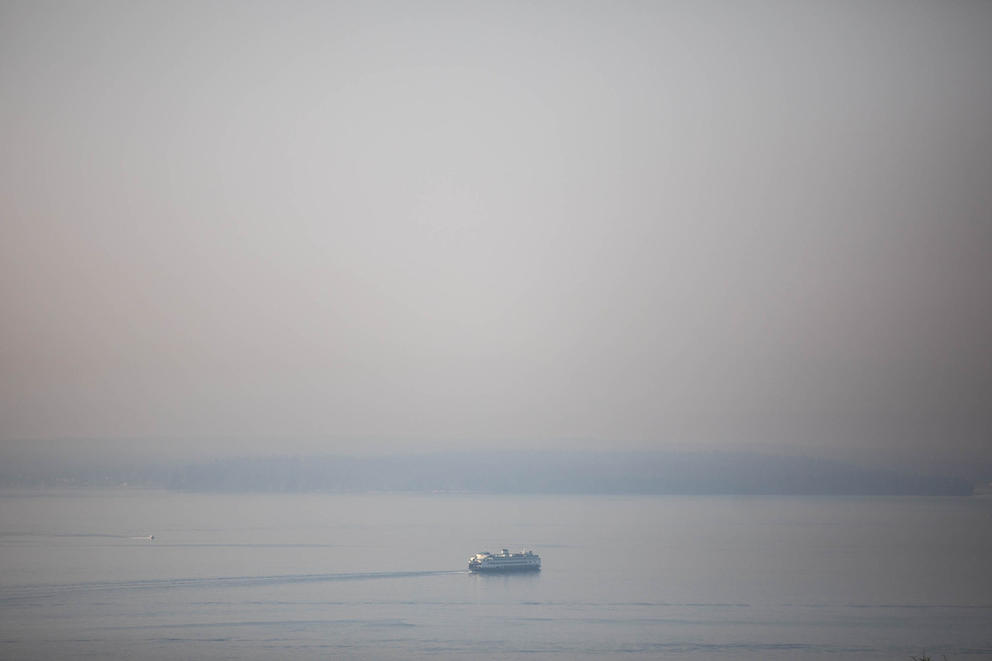With her nasal drip, sore throat and fatigue, it was hard to tell the difference. Godwin doesn’t consider herself a member of a group sensitive to wildfire smoke — for example, people with preexisting conditions or outdoor workers — but her symptoms were popping up even as smoke concentrations fell below what the Air Quality Index deems unhealthy. She was positive that wildfire exposure was behind her health challenges: Her eyes burned when the smoke spread into King County from the Bolt Creek Fire near Skykomish and other fires, even on days this fall when she wasn’t frequently outside. She tested negative for COVID-19.
“There were days when [the smoke fatigue] was so bad that I couldn’t even do my work,” said Godwin, a statistical demographer at the University of Washington who researches population health and mortality.
Seattle residents who grew up here don’t have childhood memories of wildfire-smoke-filled summers. But they’ve become a normal occurrence within the nine years that Godwin has lived in the Pacific Northwest.
“I’ve watched this transition happen … and it’s systemically depressing,” Godwin said.
Wildfire seasons are starting earlier and ending later on average, with more smoky days in between. Many people are concerned about the long-term impacts of living through multiple days of smoke, known as “smoke waves,” as well as the cumulative impacts of yearly smoke exposure.
In the past few decades, scientists have started researching the health effects of wildfire smoke, using a lot of data on its acute effects. The sheer regularity and duration of smoke may force us to reconsider the dangers it poses even to people who aren’t considered sensitive, and how we communicate its relative dangers through tools like the Air Quality Index, or AQI.
“I think we’re all sort of struck and have this sense of a wakeup call, that there’s a fifth season now: wildfire smoke season,” said UW pediatrician and epidemiological researcher Dr. Catherine Karr.
Starting to understand the health effects of more smoky days
Many types of U.S. air pollution, like from traffic and industry, began declining after the Clean Air Act was enacted in 1963. But ever-growing pollution from wildfire smoke is neutralizing many of these air quality gains.
The Air Quality Index (AQI) is a tool meant to help people assess their personal health risk at different amounts of air pollution, which can include wildfire smoke. (Washington Department of Ecology)
According to the Washington Department of Ecology, Washington state and King County both hit records for days rated moderate or worse on the Air Quality Index in 2022’s smoke season, measured between June and October. The statewide average was 28 days, and King County had 46 unhealthy days.
In King County, the vast majority of those days came all at once in September and October. “This year is the first time we’ve seen widespread smoke through October, or any smoke [that month] to speak of in Western Washington,” said the Dept. of Ecology’s Andrew Wineke. Smoke days in the state increased nearly 65% between the periods of 2009-2013 and 2016-2020, according to NPR’s California Newsroom.
Smoke, composed of water vapor as well as particles 2.5 micrometers or smaller (known as PM2.5), is particularly good at lodging itself in our bodies.
Thirty times finer than a human hair, smoke particles enter our airways, navigate the trachea, branch into the bronchae and its smaller bronchioles and eventually wedge deeply into our alveoli, the small capillary-wrapped sacs that diffuse oxygen into our bloodstream while taking in the carbon dioxide we eventually breathe out. The particulate remnants of singed trees, buildings and the chemicals inside them clog these sacs and can also pass into and damage other organs.
The first people to feel smoke’s short-term effects are those in “sensitive groups,” considered vulnerable to smoke in lower concentrations, such as those over 65 or with health conditions like asthma and COPD, as well as children and outdoor workers.
The longer someone is exposed to smoke and the greater the exposure, the more likely it will cause health problems, said Dr. Coralynn Sack, an assistant professor and physician-scientist within UW’s Department of Environmental and Occupational Health Sciences and the UW School of Medicine. The first signs include inflammation, detectable only in a blood sample. Then come noticeable symptoms, such as a cough, a headache or difficulty breathing, which may be bad enough to send someone to the doctor’s office. People may end up in the hospital with asthma attacks, strokes, heart attacks and other emergencies, and in the most dire cases, die.
In 2019, UW researchers found that people were 1% more likely to die from non-traumatic causes like strokes or heart attacks on days they’re exposed to wildfire smoke than on a typical day, and 2% more likely on the day after that exposure. One study published in 2021 found that short-term wildfire smoke exposure kills more than 33,000 people globally each year.
But many questions remain about the broader health effects more wildfire smoke has on all of us, enough to keep researchers busy for decades.
The health effects of more and longer smoke exposure
Researchers want to know more about how the amount of smoke and the length of a smoke wave affect the health of everyone, as well as the cumulative health effects of living through more smoky days overall. Earlier this year, a collaboration led by Princeton researchers estimated that wildfire activity will double or triple PM 2.5 pollution in the late summer through fall in the Western U.S. in the coming decades.
Few studies of multiweek or multimonth exposures have been done on the general population, Sack said. Some studies on wildland firefighters — who are exposed to vastly more smoke than the average person — show small declines in lung function after a season of work. There’s concern that children exposed to smoke in utero and in their early years may have impaired lung development, as well as evidence that pregnant people exposed to smoke have babies with lower birth weights.
Conducting long-term studies with human subjects is difficult. Smoke-exposure research is a newer field, with most studies published in the past decade, said Jason Sacks, a senior epidemiologist in the EPA’s Office of Research and Development. The sudden and mercurial nature of fire weather makes it difficult to know well in advance where wildfire smoke might pop up, or where someone might get exposed to it multiple times. It’s hard to control for the increasing exposures people have in indoor and outdoor settings. And because nearly everyone breathes in smoke particles, increasingly fewer people are available to participate in a control group.
Even without long-term wildfire-smoke impacts data, scientists have decades of data on PM2.5 pollution in general that suggests chronic exposure to poor air is harmful.
UW’s Sack notes that years-long exposure to traffic pollutants, even within regulatory levels, exacerbates atherosclerosis, a medical condition that causes heart attacks. Historically redlined neighborhoods closer to traffic and industrial pollution experience higher levels of respiratory disease. The EPA’s Sacks said long-term exposure to PM 2.5 increases overall mortality. Traffic and wildfire-based PM 2.5 differ chemically, but it’s likely they have similar long-term medical effects.
UW smoke-impact expert Dr. Tania Busch Isaksen, who researches and teaches in the Department of Environmental and Occupational Health Sciences, said area researchers including herself are currently investigating the cumulative impact of smoke in lower health advisory categories, and she said they are close to publishing those results.
Annie Doubleday, a PhD student at UW and one of Busch Isaksen’s collaborators, said the researchers are trying to understand whether exposure to smoke over several days increases emergency department visits. Researchers in British Columbia found that over multiple recent fire seasons, respiratory ambulance calls increased in the 48-hour period after wildfire smoke exposure.
Another UW study from 2021 estimated about 93 people died when wildfire smoke spread across Washington for 13 days in September 2020.
Think twice when you check the AQI
At the height of the October smoke, Seattleites found themselves anxiously checking the AQI day after day to see if it was safe to exercise or even go outside. But the Air Quality Index doesn’t tell us everything we need to know to manage our health in a smoke event.
The EPA’s AQI, first issued in 1976, is a rough six-category alert system tied to national ambient air-quality standards meant to help people figure out whether activities like going outside or exerting themselves on a given day might put them at greater health risk. Officially, AQI offers a 24-hour average of PM 2.5 pollutant concentration in an area and does not take into account the previous days’ concentrations. Most people encounter AQI alerts through the EPA’s AirNow website and app or the website IQAir. AirNow uses an algorithm called NowCast to share hourly estimates for AQI based on the past half-day of air-quality data, or three hours during wildfire events. IQAir also shares algorithm-based AQI hourly estimates which are based on the previous hour’s data.
Many people likely don’t realize that AQI readings during wildfires include other pollution from traffic and industrial sources.
“There is now research showing that wildfire smoke may be more toxic than particle pollution from other sources,” Doubleday said.
The scientific community is struggling to find the best means of communicating the effects of longer smoke exposure, the EPA’s Sacks said, “because we know that being outside, even when it’s [moderate], for multiple days, isn’t great.”
While the AQI is meant to help people make personal health decisions, it’s based on population-level health data and not tailored to anyone’s specific health situation.
“I think these guidelines are doing the best we can sort of at a population scale … but it’s like, there’s no way you can go in, answer a set of questions, and get a [personalized] score,” Karr says.
Doubleday said longer periods of smoke exposure are harder on our bodies than shorter periods are. She tells people that, regardless of whether they fall into a designated sensitive group, they should monitor for symptoms at all levels of the AQI, and get to a clean indoor space if they notice symptoms.
Some experts say that exposure to low levels of smoke could be hazardous explicitly because people don’t take as many precautions.
Negligence — or lack of access to safety measures — adds up. In an interview with UC Davis Magazine, Dr. Irva Hertz-Picciotto said people who are repeatedly exposed to wildfire smoke may feel the symptoms of exposure at less-dangerous concentrations of smoke.
“An alternate air quality rating system for wildfire smoke that considers cumulative exposure (and/or peak exposure) is definitely something to consider,” Doubleday said via email.
Karr said planning for more smoke should include sourcing N95 masks for outside use and setting up clean rooms — sealed rooms stocked with HEPA air purifiers or central ventilation systems, food and medications where people can hunker for days. This is harder for renters whose homes aren’t sufficiently sealed; unhoused neighbors who may rely on city governments for clean air shelters; or outdoor workers who look to employers to provide safe spaces and protective equipment.
Ultimately, no amount of smoke is healthy to breathe.
“There's no threshold below which we don't see health effects,” said Sacks of the EPA. “Granted, as you get the higher concentrations, more than likely everyone's going to get some response … but I think it's important to recognize that even though there's levels that are green [healthy], it doesn't mean it's completely safe.”






